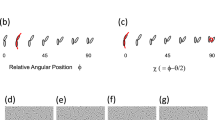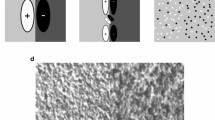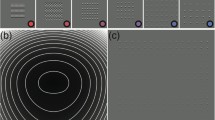Abstract.
This study was designed to ascertain whether the human visual system can segregate overlapped surfaces by integrating texture borders at second-order X-junctions. The stimuli used were crossed vertical and horizontal stripes consisting of Gabor micro-patterns. We manipulated the orientation of the center region of each stripe. Observers judged whether the crossed stripes appeared as “two overlapped stripes” or “five individual regions.” The results showed that the probability of perceiving overlapped stripes exceeded the chance level (0.5) when the orientation differences between the center and flanking regions were less than 30°. We suggest that the integration of texture borders along each stripe occurs by the filter-rectify-filter mechanism, resulting in the impression of overlapped surfaces. When this fails, the outcome is the perception of five individual regions.



Similar content being viewed by others
References
Adelson EH (1993) Perceptual organization and the judgment of brightness. Science 262:2042–2044
Ahissar M, Hochstein S (1995) How early is early vision? Evidence from perceptual learning. In: Papathomas TV, Chubb C, Gorea A, Kowler E (eds) Early vision and beyond. MIT Press, MA, pp 199–206
Arsenault AS, Wilkinson F, Kingdom FAA (1999) Modulation frequency and orientation tuning of second-order texture mechanisms. J Opt Soc Am A 16:427–435
Beck J (1966) Effect of orientation and of shape similarity on perceptual grouping. Percept Psychophys 1:300–302
Bergen JR (1991) Theories of visual texture perception. In: Regan D (ed) Vision and visual dysfunction, vol 10, Spatial vision. Macmillan, New York, pp 114–134
Bergen JR, Adelson EH (1988) Early vision and texture perception. Nature 333:363–364
Field DJ, Hayes A, Hess RF (1993) Contour integration by the human visual system: evidence for a local association field. Vision Res 33:173–193
Gorea A, Papathomas TV (1993) Double opponency as a generalized concept in texture segregation illustrated with stimuli defined by color, luminance, and orientation. J Opt Soc Am A 10:1450–1462
Kawabe T, Miura K (2004) Configuration effects on texture transparency. Spatial Vis 17:187–200
Kingdom FAA, Keeble DRT (2000) Luminance spatial frequency differences facilitate the segmentation of superimposed textures. Vision Res 40:1077–1087
Kingdom FAA, Prins N, Hayes A (2003) Mechanism independence for texture-modulation detection is consistent with a filter-rectify-filter mechanism. Vis Neurosci 20:65–76
Landy MS, Bergen JR (1991) Texture segregation and orientation gradient. Vision Res 31:679–691
Langley K, Fleet DJ, Hibbard PB (1996) Linear filtering precedes nonlinear processing in early vision. Curr Biol 6:891–896
Mareschal I, Baker CL Jr (1998) A cortical locus for the processing of contrast-defined contours. Nature Neurosci 1:150–154
Mitsudo H (2003) Information regarding structure and lightness based on phenomenal transparency influences the efficiency of visual search. Perception 32:53–66
Motoyoshi I, Nishida S (2001) Visual response saturation to orientation contrast in the perception of texture boundary. J Opt Soc Am A 18:2209–2219
Motoyoshi I, Nishida S (2002) Spatiotemporal interactions in detection of texture orientation modulations. Vision Res 42:2829–2841
Prins N, Kingdom FAA (2002) Orientation- and frequency- modulated at low depth of modulation are processed by off-orientation and off-frequency texture mechanisms. Vision Res 42:705–713
Prins N, Kingdom FAA (2003) Detection and discrimination of texture modulations defined by orientation, spatial frequency, and contrast. J Opt Soc Am A 20:401–410
Sutter A, Sperling G, Chubb C (1995) Measuring the spatial frequency selectivity of second-order texture mechanisms. Vision Res 35:915–924
van Tonder GJ, Ejima Y (2000) From image segmentation to anti-textons. Perception 29:1231–1247
Watanabe T, Cavanagh P (1996) Texture laciness: the texture equivalent of transparency? Perception 25:293–304
Wenderoth P, Clifford CW, Wyatt AM (2001) Hierarchy of spatial interactions in the processing of contrast-defined contours. J Opt Soc Am A 18:2190–2196
Wolfson SS, Landy MS (1998) Examining edge- and region-based texture analysis mechanisms. Vision Res 38:439–446
Acknowledgements.
We thank the anonymous reviewer for helpful and constructive criticisms of previous versions of the manuscript. We also thank Muhammad Kamal Uddin for correcting the English language.
Author information
Authors and Affiliations
Corresponding author
Rights and permissions
About this article
Cite this article
Kawabe, T., Miura, K. Surface segregation driven by orientation-defined junctions. Exp Brain Res 158, 391–395 (2004). https://doi.org/10.1007/s00221-004-2065-0
Received:
Accepted:
Published:
Issue Date:
DOI: https://doi.org/10.1007/s00221-004-2065-0




